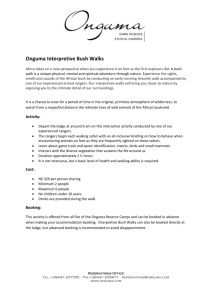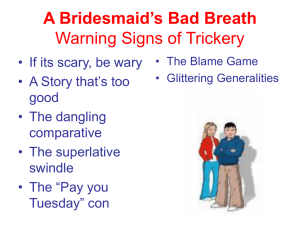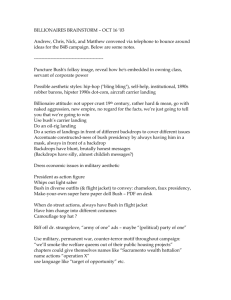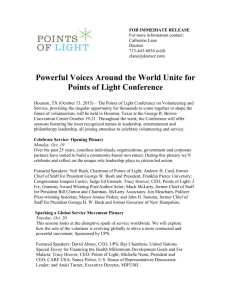Theory: Emotional or affective reactions to political leaders are an
advertisement
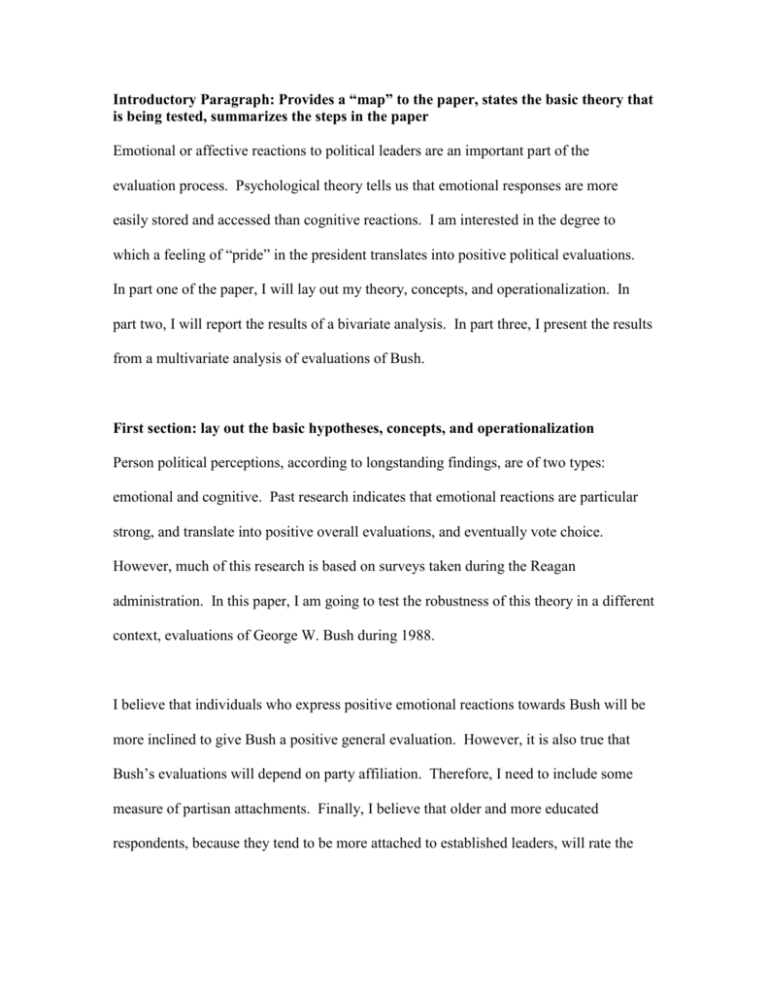
Introductory Paragraph: Provides a “map” to the paper, states the basic theory that is being tested, summarizes the steps in the paper Emotional or affective reactions to political leaders are an important part of the evaluation process. Psychological theory tells us that emotional responses are more easily stored and accessed than cognitive reactions. I am interested in the degree to which a feeling of “pride” in the president translates into positive political evaluations. In part one of the paper, I will lay out my theory, concepts, and operationalization. In part two, I will report the results of a bivariate analysis. In part three, I present the results from a multivariate analysis of evaluations of Bush. First section: lay out the basic hypotheses, concepts, and operationalization Person political perceptions, according to longstanding findings, are of two types: emotional and cognitive. Past research indicates that emotional reactions are particular strong, and translate into positive overall evaluations, and eventually vote choice. However, much of this research is based on surveys taken during the Reagan administration. In this paper, I am going to test the robustness of this theory in a different context, evaluations of George W. Bush during 1988. I believe that individuals who express positive emotional reactions towards Bush will be more inclined to give Bush a positive general evaluation. However, it is also true that Bush’s evaluations will depend on party affiliation. Therefore, I need to include some measure of partisan attachments. Finally, I believe that older and more educated respondents, because they tend to be more attached to established leaders, will rate the President more highly than younger and less well educated respondents. My theory is laid out in Figure one, with the hypothesized direction of effects indicated on the arrows. For my data, I will use the 1988 National Election Study, collected by the University of Michigan. For my measure of evaluations of George Bush, I use the 100 point feeling thermometer, where 0 means that you feel negatively towards Bush and 100 means that you feel positively towards Bush. For my measure of pride, I use a variable which asks respondents whether “anything George Bush has done has ever made you feel proud?” The variable is coded as a dummy variable, 1=yes (Bush made me feel proud). Party ID runs from 0 (strong Democrat) to 1 (strong Republican). Partisan attachment is measured by the standard 7 point scale reported by the NES, where 0=strong Democrat and 6=strong Republican. While it is not ideal, for the purposes of this research, I will treat this variable as an interval scale for the purposes of multiple regression. My basic hypotheses are contained in the arrow diagram reported in Figure One. Figure One: Causal Diagram for Bush’s Feeling Thermometer Are you proud of Bush? Party Affiliation (Republicanism) + + Bush Feeling Thermometer Age, Education Second section: First analyses. Describe the DV and do the bivariate analysis Did George Bush evoke pride in the American public? In the 1988 survey, 69% of the respondents responded that Bush had made them feel proud. This seems a rather high number, and may indicate that respondents are unwilling to tell the respondent negative things about prominent political figures. Or it might be that nearly every prominent politician has done something to evoke pride at some point. (Creativity alert: a good analyst would compare the percent expressing pride in other prominent political figure) My first hypothesis is that people who thought George Bush made them feel proud would give Bush a higher score on the feeling thermometer than those who did not think Bush made them feel proud. As Table 1 shows, this hypothesis is strongly confirmed. The average feeling thermometer score among those who thought Bush made them feel proud was 75.09, nearly 27 points higher than those who did not think that Bush made them feel proud. I have put alternative statements here. Using the difference of means test, this difference is significant at the 95% level, meaning that there is a less than 5% chance that differences as large as observed here could have appeared by chance. We can reject the null hypothesis that there is no difference in feeling thermometer rankings between those who felt that George Bush made them feel proud and those who did not. Table 1: Average Bush Feeling Thermometer by Pride Does YES Bush NO make you TOTAL feel proud? Third Section: Multivariate analysis 75.09% 48.45% 56.64% It is possible, however, that the relationship reported above is spurious. There could be omitted variables that are correlated with “pride” that are excluded from the analysis. For example, I hypothesize that Republicans are more likely to say that Bush made them feel proud than are Democrats. A multivariate analysis allows me to take both of these variables into account. I also include demographic controls, age and education, under the assumption that older respondents and better educated respondents will be more positively inclined towards Bush. Thus, I will estimate this equation via ordinary least squares regression: BushFT 1 2 Pr ide 3 PartyID 4 Education 5 Age The results from my regression are reported in Table 2. Note my formatting here. You should left justify the variable names and right justify the table values. This way all of the decimal points line up. Note also how I have put in “0” to make some of the decimals line up. Table 2: Regression Analysis of Bush Evaluations B Pride Party ID Age Education Constant 18.487 4.938 0.027 -1.264 41.307 SE(B) 1.090 0.246 0.027 0.295 1.883 T-statistic Probability 16.959 20.047 1.025 -4.292 21.941 0.000 0.000 0.306 0.000 0.000 Note that Gronke did not include the R-squared or the sample size. This is not right and will lose him some points. My first hypothesis is strongly confirmed. If you felt that Bush made you feel proud, you gave Bush an 18 point higher score on the feeling thermometer. This relationship is strongly statistically significant (t=16, p<0.000). We can continue to reject the null hypothesis of no difference …. My second hypothesis, that Republicans give Bush higher scores than do Democrats, is also strongly confirmed. Each movement of one point on the scale of partisanship is associated with a 5 point increase in the feeling thermometer. Make sure you see how I got this. Across the full range of the variable, this translates into nearly one-third of the range of the variable (6*4.9=29.4). It is also interesting that the effect of this variable across its full range is greater than the effect of pride. Not surprisingly, partisan attachments continues to be the most important determinant of political attitudes. The effect is also strongly statistically significant (p<0.000). Among my demographic controls, older people appear no more likely to give Bush a positive feeling thermometer score than do younger people. While the estimated effect of age is positive (.027), the standard error on this coefficient is large enough (.019) that we cannot say with 95% confidence that the true population value is not zero (p=.306). Thus, my data indicate that there is no difference in evaluation of Bush as we move up the age scale. Finally, education works opposite from the direction that I predicted. Each movement up the scale of education is associated with a 1.2 point drop in the feeling thermometer score, all other things being held equal. My model predicts that the best educated respondents will rate Bush 7.2 points lower (7*-1.2 – 1*-1.2=6*-1.2) on the feeling thermometer. This result is also statistically significant (p=0.000). I believe that education may not have a linear effect at all, but in fact the most liberal segments of the population are the least well and the most well educated. That accounts for the reversed sign from my initial hypothesis. Then why don’t you go test this?? Conclusion: Here you should restate your initial theory, why this is an interesting question, summarize your results, and perhaps point out what you might have done with more time and space.



